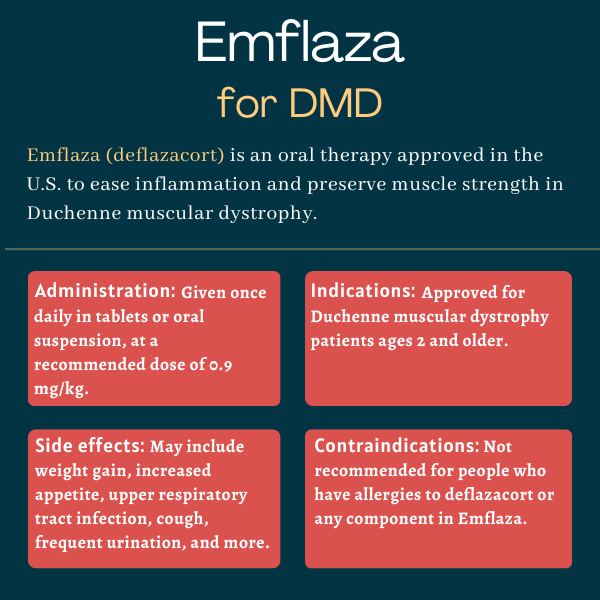Emflaza (deflazacort) for Duchenne muscular dystrophy
Last updated May 20, 2024, by José Lopes, PhD

What is Emflaza for Duchenne muscular dystrophy?
Emflaza (deflazacort) is an oral corticosteroid approved in the U.S. to ease inflammation and preserve muscle strength in individuals with Duchenne muscular dystrophy (DMD), ages 2 and older.
Marketed by PTC Therapeutics, the treatment is administered as oral tablets or an oral suspension.
Therapy snapshot
| Brand name: | Emflaza |
| Chemical name: | Deflazacort |
| Usage: | Therapy to preserve muscle function in DMD patients |
| Administration: | Oral tablets and liquid suspension |
How does Emflaza work?
Duchenne muscular dystrophy, known for short as DMD, is a rare genetic disease caused by mutations in the gene that codes for dystrophin, an important protein that supports muscle cells during muscle contraction. These mutations lead to virtually no functional dystrophin being produced, which results in progressive muscle damage and weakness.
When damage occurs, the immune system normally launches an immune response in an attempt to clear the damaged tissue and initiate the repair process. In DMD, however, that inflammatory response is believed to play a key role in disease progression, as the ongoing muscle damage causes inflammation to become dysregulated and chronic.
Corticosteroids are medications commonly prescribed in DMD that reduce inflammation by mimicking the effects of the hormone cortisol. By easing the inflammatory response, these medications are expected to reduce muscle damage and preserve muscle strength and function.
Emflaza is a corticosteroid prodrug, which means it must be converted in the body to its active corticosteroid form. Once metabolized, Emflaza acts through the glucocorticoid receptor to exert anti-inflammatory effects and suppress the immune system.
Who can use Emflaza?
Emflaza was initially approved by the U.S. Food and Drug Administration (FDA) in February 2017 to treat DMD patients ages 5 and older. With that decision, it became the first corticosteroid therapy approved for DMD.
The indication was then expanded in 2019 to cover patients as young as age 2.
The drug has been available in Europe for several decades, where it is sold as Calcort, among others, and used off-label to treat DMD patients.
Who should not use Emflaza?
Emflaza is contraindicated, or not recommended, for people who have experienced an allergic reaction to deflazacort or any other ingredient in the therapy.
The drug also should not be used in people with an active eye infection with the herpes simplex virus, or in those using moderate or strong inducers of the CYP3A4 enzyme, which is required to break down Emflaza’s active ingredient.
Caution also is recommended when administering Emflaza to patients with heart failure, high blood pressure, or kidney insufficiency.
How is Emflaza administered?
Emflaza is available as tablets or an oral suspension that come in five different strengths:
- 6 mg oral tablets, which are white and round and have a “6” debossed on one side
- 18 mg oral tablets, which are white and round with “18” debossed on one side
- 30 mg white and oval tablets, with “30” debossed on one side
- 36 mg white and oval tablets, with “36” debossed on one side
- 22.75 mg/mL whitish suspension.
The medication’s recommended dose is approximately 0.9 mg per kg of body weight per day. If tablets are used, any combination of tablet strengths can be used to achieve the total daily dose.
If the oral suspension is used instead, the oral dispenser that comes with the product should be used to withdraw the appropriate dose, which should then be mixed with 3-4 ounces of juice or milk. Grapefruit juice should not be used.
Emflaza can be taken with or without food, but should not be administered with grapefruit juice. Tablets may be taken whole or crushed.
If patients are taking moderate or strong inhibitors of CYP3A4, Emflaza’s dose should be adjusted to one-third of the recommended dose.

Emflaza in clinical trials
Emflaza was initially approved based on data from a Phase 3 clinical trial that enrolled boys with DMD, ages 5 to 15, as well as a two-year study involving boys ages 6 to 12. Its label expansion was then based on results from an observational clinical trial (NCT00468832), completed in 2019, that included patients as young as 2.
Phase 3 trial
The double-blind trial, which was completed in 1995, included 196 boys with DMD who had experienced the first signs of muscle weakness before age 5. Participants were enrolled across nine centers in the U.S. and Canada, and were treated in two phases.
In the first part, patients were randomly assigned to receive either Emflaza (0.9 or 1.2 mg/kg), the standard corticosteroid prednisone, or a placebo daily for 12 weeks, or about three months. In the second part, patients who had been given the placebo received either Emflaza or prednisone for 40 weeks, or about 10 months. Those already on Emflaza or prednisone continued with their assigned treatment.
The trial’s main goal was to determine changes in muscle strength over the first 12 weeks, as assessed with the Medical Research Council (MRC) scale. Secondary measures included changes in muscle strength in the trial’s second part, and lung function.
The results showed that both Emflaza doses and prednisone significantly improved muscle strength in the first 12 weeks, as compared with a decline seen in the placebo group. However, only the 0.9 mg/kg dose of Emflaza resulted in sustained improvements that remained significant up to week 52, or the one-year mark.
Tests of participants’ function — measuring the time it took to stand from a supine position, to climb four stairs, and to walk or run 30 feet — also showed improvements with Emflaza compared with prednisone at week 52, but the differences failed to reach statistical significance.
Side effects, including serious adverse reactions and those leading to treatment discontinuation, all were more common in patients given prednisone than Emflaza. Also, gains in weight, a common side effect of steroid therapies, were lower with Emflaza than with prednisone.
Two-year trial
This double-blind trial enrolled 29 patients who were randomly assigned to receive Emflaza or a placebo for 104 weeks, or two years. The study assessed the change in average muscle strength or loss of ambulation, at which point patients were discontinued from the trial.
Greater average muscle strength was seen among boys treated with Emflaza compared with those on the placebo, as was a longer time to loss of ambulation in the treated group. The changes, however, failed to reach statistical significance, possibly due to the low number of patients in the placebo group (due to loss of ambulation) after two years.
Observational study
A longitudinal observational study was launched in 2005 to establish the long-term effects of steroids — Emflaza and prednisone — on disease progression. A total of 440 men and boys with DMD, ages 2 to 28, were enrolled during two recruitment periods, the first from 2006 to 2009 and the second spanning 2012 to 2016. All participants were followed for 10 years afterward.
Nine clinically meaningful mobility and upper limb milestones were assessed regarding disease progression. These measures included muscle testing, pulmonary function examinations, and functional evaluations such as range of motion, the nine-hole peg test of finger dexterity, and the six-minute walk test of exercise capacity.
The results showed that time to disease progression was significantly longer in participants who received Emflaza or prednisone for one year or longer compared with those who received these medications for shorter periods or were never treated with them.
Importantly, treatment with Emflaza tended to delay a number of milestone transitions compared with prednisone therapy. Specifically, patients on Emflaza lost their ability to stand from a laying position, the ability to walk, and hand-to-mouth function at significantly older ages compared with those given prednisone.
Side effects of Emflaza
The most common side effects associated with Emflaza in DMD clinical trials include:
- Cushingoid appearance, or symptoms linked to Cushing’s syndrome, in which patients have cortisol in circulation
- weight gain
- increased appetite
- upper respiratory tract infection
- cough
- frequent urination, known as pollakiuria
- hirsutism, or excess hair
- abdominal obesity
- the common cold.
Changes in endocrine function
Long-term use of corticosteroids such as Emflaza may lead to serious and life-threatening changes in hormone production. Patients should be monitored for Cushing’s syndrome, increased blood sugar levels, and adrenal insufficiency after stopping Emflaza therapy. Adrenal insufficiency occurs when the adrenal glands don’t make enough of certain hormones.
Increased risk of infection and vaccination
Because corticosteroids suppress the immune system, their use can increase the risk of infections. Particular attention is recommended for chickenpox caused by the varicella zoster virus and measles, hepatitis B reactivation, body-wide fungal infections, amebiasis, which is caused by a parasite called Entamoeba histolytica, and threadworm infestation, some of which may be fatal.
Given that Emflaza suppresses the immune system, patients are recommended to be vaccinated with live or live-attenuated vaccines at least four to six weeks before starting on the medication. Other types of vaccines may be given during treatment.
Cardiovascular and renal problems
Emflaza and other corticosteroids may cause an increase in blood pressure and salt and water retention, and increase the excretion of potassium and calcium. Patients should be monitored for changes in blood pressure and for any other signs of these issues. Restricting salt and potassium in the diet may be required.
Particular caution should be taken when using Emflaza for people with congestive heart failure, high blood pressure, renal insufficiency, and a tear in the heart’s left ventricle after a recent heart attack.
Gastrointestinal perforation
People with certain gastrointestinal disorders may be at risk of gastrointestinal perforation, or a tear, during corticosteroid use. Signs of gastrointestinal perforation may be masked in these patients. Corticosteroids should be avoided if an impending perforation or a related disorder is possible.
Behavioral and mood changes
Treatment with Emflaza and other corticosteroids may cause severe psychiatric disorders such as euphoria, insomnia, and mood changes, and depression may also occur after stopping the medication. Reducing or stopping Emflaza therapy may needed for these patients, who should be encouraged to seek medical attention, especially if they experience a depressed mood or suicidal thoughts.
Bone fragility and eye problems
Patients on chronic Emflaza treatment should be monitored for bone mineral density, as corticosteroids decrease bone formation and increase bone resorption. This loss of bone density, known as osteoporosis, may lead to fractures. Patients also may experience avascular necrosis, a condition marked by the death of bone tissue due to a lack of blood supply.
Eye problems, such as cataracts and glaucoma, which is high blood pressure in the eye, also may occur. Pressure in the eye should be monitored if treatment with Emflaza lasts more than six weeks. Corticosteroids are not recommended for people with active ocular herpes simplex.
Serious skin rashes and allergic reactions
As toxic skin reactions have been reported with the use of Emflaza’s active ingredient deflazacort, treatment should be discontinued at the first sign of rash, unless it is clearly not drug-related.
Use of Emflaza and other corticosteroids also has been associated in rare instances with anaphylaxis, a severe, life-threatening allergic reaction.
Muscle disease
Acute myopathy, or muscle disease, may occur in patients receiving corticosteroids along with neuromuscular blocking agents, as well as in individuals with issues in which the nerves and muscles are not communicating properly. This problem is generalized and may involve eye and respiratory muscles. Clinical improvement after stopping corticosteroids may take years.
Kaposi’s sarcoma
Kaposi’s sarcoma — a type of cancer that forms lesions in the skin and gastrointestinal mucosa — has been reported in patients being treated with corticosteroids, particularly for chronic conditions. Discontinuation of corticosteroids may be beneficial in such cases.
Serious adverse reactions in infants
In its oral suspension formulation, Emflaza contains an ingredient called benzyl alcohol that has been associated with potentially fatal side effects in newborns and low birth weight infants. Emflaza is not approved for use in children younger than 2.
Blood clotting events
Studies have reported a higher risk of thromboembolism, or blood clots, particularly as the total dose of corticosteroids a patient is given increases. In this regard, Emflaza should be used with caution in patients predisposed to blood-clotting disorders.
Pregnancy and breastfeeding
Because corticosteroids can cross the placenta and have been reported to cause some developmental issues during pregnancy, they should only be used during this period if the potential benefit to the mother outweighs the potential risks to the developing fetus.
If a decision is made to start on corticosteroids during pregnancy, babies exposed to substantial doses of corticosteroids should be checked for signs of hypoadrenalism — a disorder in which the adrenal glands do not produce adequate amounts of steroid hormones, including cortisol.
Corticosteroids also have been detected in human milk and may suppress an infant’s growth. As such, the benefits of breastfeeding should be considered along with the mother’s need for Emflaza and the potential adverse effects on the breastfed infant. No data exist on Emflaza’s effects on milk production.
Patients who are or plan to become pregnant, or are nursing or plan to breastfeed, should discuss this topic with their healthcare providers.
Muscular Dystrophy News Today is strictly a news and information website about the disease. It does not provide medical advice, diagnosis, or treatment. This content is not intended to be a substitute for professional medical advice, diagnosis, or treatment. Always seek the advice of your physician or other qualified health provider with any questions you may have regarding a medical condition. Never disregard professional medical advice or delay in seeking it because of something you have read on this website.
Related articles






